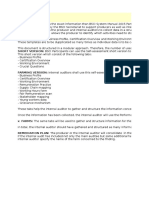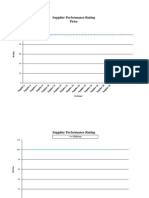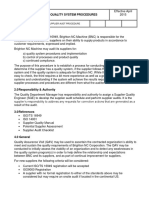Printing Defect
Uploaded by
røhìtkPrinting Defect
Uploaded by
røhìtkPRINTING DEFECT
Flushing/Wicking Caused due to Low viscosity of print paste. It occurs when the printed area bleeds out into the UN printed area. The result is a haloing or shadowing effect around the outline of the pattern design.
Bleeding Misfits A misfit is a print defect caused by improper alignment of the screens. Also known as ted areas in the design. For example, a green leaf may overlap its black outline or print over another color. Caused due to Low viscosity of print paste It is major defect as it happens throughout the fabric unless the viscosity is corrected.
Stick-ins A stick-in occurs when a small fiber or piece of lint gets stuck in the screen opening. The result is a small unprinted circle in the design. A stick-in is very difficult to see and often goes unnoticed during a long run.
Back Fabric Seam Impression Backing fabric is often used to cushion fabric being printed. If there is a joining seam in the backing fabric, an impression will result on printed fabric.
Color Smear The result of color being smeared during printing.
Color Out The result of color running low in reservoir on printing machine
Mottled Color applied unevenly during printing
Crack or miss alignment in transfer printed fabric. Incomplete transfer of design from paper to fabric on transfer printing due to removal of transfer of paper while the fabric was still hot.
Colour Drag-Colour of the print smears or smudges from rubbing against an object before it becomes dry. Colour Splatter-The print paste instead of being placed on the fabric is thrown or splattered onto thefabric surface. Fuzzy Pattern-The edges of patterns are not sharp, clear lines, but are instead rather fuzzy lines. Most frequently caused by improper singeing or improperly thickened print paste. Off-register-Printing rolls or screens improperly aligned so pattern parts do not meet properly. This imperfection is also called out-of-fit or out-of-register. Stop Mark-Colour streak across the fabric resulting from the printing machine being stopped during the printing process and then starting again. Tender Spots-In printed fabrics; one or more colours of the print may cause weakened areas where they were printed. Usually due to excessive use of injurious chemicals in the print paste. May also be found in the discharged area of discharge prints.
You might also like
- Climate Change Information Request Response CDPNo ratings yetClimate Change Information Request Response CDP44 pages
- Jon Porter Mejores Prácticas en CorrugadoptimizeNo ratings yetJon Porter Mejores Prácticas en Corrugadoptimize133 pages
- Overage / Shortage / Seal Discrepancy LogNo ratings yetOverage / Shortage / Seal Discrepancy Log1 page
- AQL Chart: Acceptance Quality Levels (Normal Inspection)No ratings yetAQL Chart: Acceptance Quality Levels (Normal Inspection)2 pages
- Quality Management: ©ian Sommerville 2000 Software Engineering, 6th Edition. Chapter 24 Slide 1No ratings yetQuality Management: ©ian Sommerville 2000 Software Engineering, 6th Edition. Chapter 24 Slide 155 pages
- Acheta Guide To Pest Control Compliance With BRC 8100% (1)Acheta Guide To Pest Control Compliance With BRC 811 pages
- Ten Most Common Reasons For FDA 483 Observations and Warning Letter CitationsNo ratings yetTen Most Common Reasons For FDA 483 Observations and Warning Letter Citations11 pages
- Product Deviation Report: Date: - Control NumberNo ratings yetProduct Deviation Report: Date: - Control Number2 pages
- Sprintech: Daily Process Analysis (Printing)No ratings yetSprintech: Daily Process Analysis (Printing)1 page
- FSC STD 40 201 V2 0 en FSC On Product Labelling RequirementsNo ratings yetFSC STD 40 201 V2 0 en FSC On Product Labelling Requirements16 pages
- Guidance - Workplace Organization / Workplace + Area: 5S-Steps Ok? Examples SortingNo ratings yetGuidance - Workplace Organization / Workplace + Area: 5S-Steps Ok? Examples Sorting4 pages
- Rotogravure Print Quality Evaluation Analysis PitfNo ratings yetRotogravure Print Quality Evaluation Analysis Pitf4 pages
- Machine Preventative Maintenance Scheldule: Week 1 Week 2 Week 3 Week 4No ratings yetMachine Preventative Maintenance Scheldule: Week 1 Week 2 Week 3 Week 48 pages
- 〈661.2〉 Plastic Packaging Systems for Pharmaceutical UseNo ratings yet〈661.2〉 Plastic Packaging Systems for Pharmaceutical Use5 pages
- US Tech Online - New Levels of Traceability For Electronics ManufacturingNo ratings yetUS Tech Online - New Levels of Traceability For Electronics Manufacturing4 pages
- Potential Failure Mode and Effects Analysis Process FmeaNo ratings yetPotential Failure Mode and Effects Analysis Process Fmea24 pages



























































